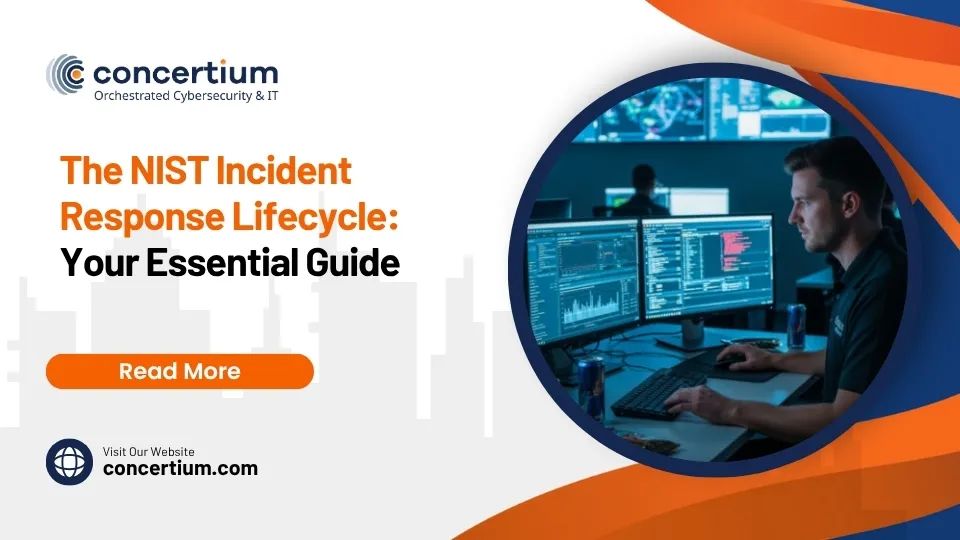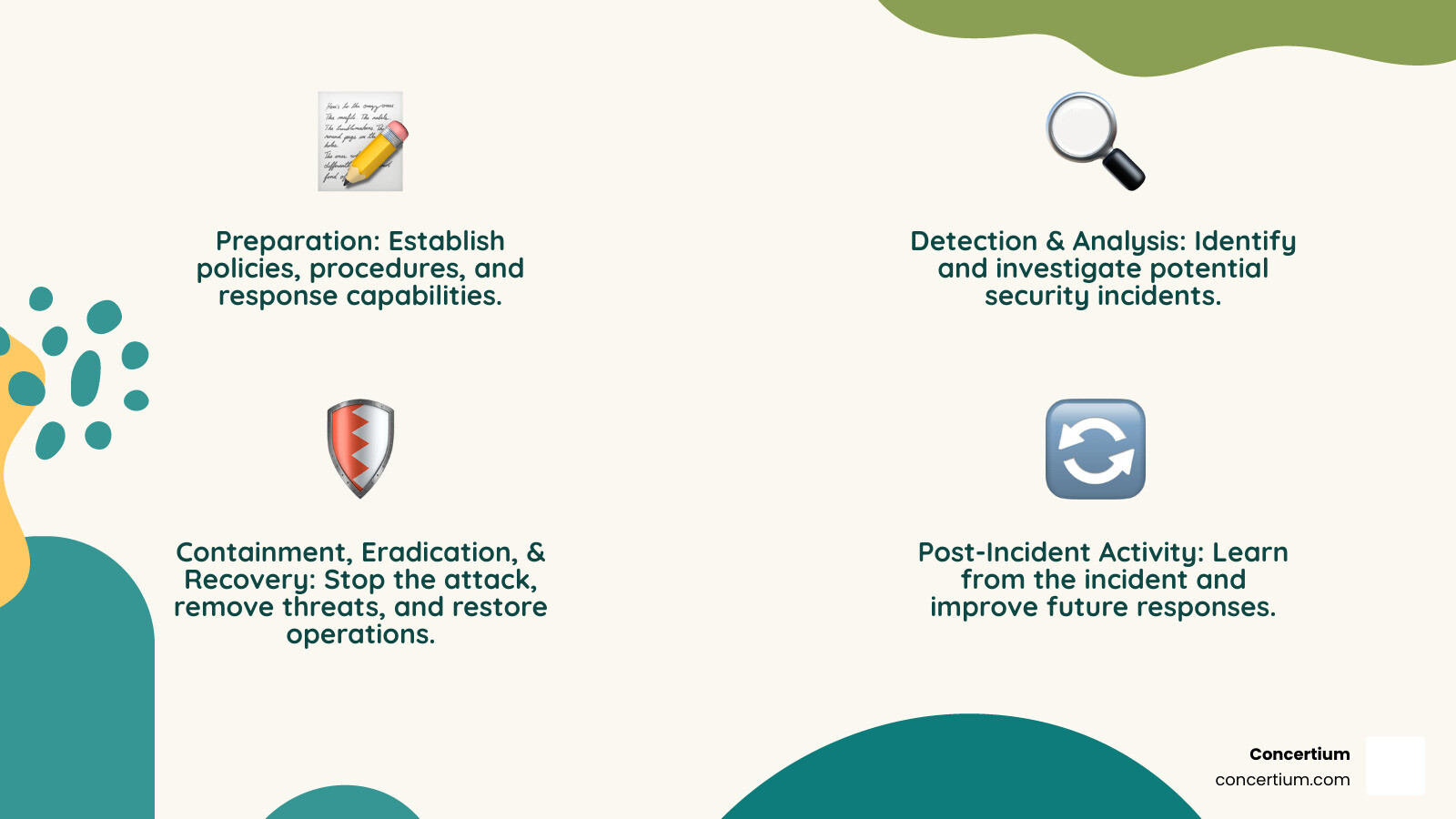The incident response lifecycle nist is a structured, four-phase framework developed by the National Institute of Standards and Technology to help organizations prepare for, detect, respond to, and recover from cybersecurity incidents. This systematic approach ensures consistent threat mitigation while minimizing business disruption and financial impact.
The Four Phases of the NIST Incident Response Lifecycle:
- Preparation – Establish policies, procedures, and response capabilities
- Detection and Analysis – Identify and investigate potential security incidents
- Containment, Eradication, and Recovery – Stop the attack, remove threats, and restore operations
- Post-Incident Activity – Learn from the incident and improve future responses
Originally outlined in NIST Special Publication 800-61 Revision 2, this framework has become the gold standard for incident response across industries. What makes it particularly valuable is its cyclical nature – each incident provides lessons that feed back into better preparation for future threats.
The framework recognizes a fundamental truth about cybersecurity: incidents are inevitable. As one security professional noted, “The smartest people in security and incident management think in cycles, not straight lines.” This mindset shift from reactive to proactive incident management can save organizations millions in potential damages.
For mid-sized businesses, the NIST framework offers a scalable approach that doesn’t require massive security teams or budgets. It focuses on building resilience rather than just prevention, acknowledging that even well-protected organizations will face security incidents.
Incident response lifecycle nist vocabulary:
- Cyber incident response planning
- incident management maturity model
- nist incident response playbook template
So, why does NIST, a non-regulatory agency, provide such detailed recommendations for incident response? The answer lies in its mission and statutory obligations. Under the Federal Information Security Management Act (FISMA) of 2014, NIST is tasked with providing recommendations to federal agencies to strengthen their cybersecurity posture. This mandate extends to developing standards and guidelines for cost-effective security of information systems. While primarily for federal use, NIST’s guides, like SP 800-61, are voluntarily adopted by organizations worldwide because of their comprehensive, well-researched, and technology-agnostic nature. They offer a robust foundation for building an effective incident handling capability.
A Deep Dive into the Four Phases of the Incident Response Lifecycle NIST Framework
Think of the incident response lifecycle nist framework like a well-rehearsed emergency response team. Just as firefighters don’t wait until there’s a fire to figure out their strategy, cybersecurity teams need a systematic process for handling incidents before they happen. This four-phase approach ensures efficient threat mitigation while maintaining business continuity – something we at Concertium have seen make the difference between a minor hiccup and a business-ending disaster.
The beauty of this framework lies in its methodical approach. Each phase builds on the previous one, creating a comprehensive defense strategy that transforms reactive scrambling into proactive incident management. Let’s walk through each phase and see how they work together to protect your organization.
Phase 1: Preparation
Responding to a cyber incident without proper preparation is chaotic. This foundational phase is where we build the infrastructure and capabilities needed for an effective response.
Risk assessments form the backbone of good preparation. We need to understand what assets are most valuable and what threats they face. This isn’t just about checking boxes – it’s about creating a realistic picture of where vulnerabilities exist and how they might be exploited.
System hardening and security policies work hand-in-hand to reduce the attack surface. Think of these as your digital armor – they won’t stop every attack, but they’ll deflect many and slow down the rest. This includes everything from network perimeter security to anti-malware software deployment.
The incident response plan itself deserves special attention. This isn’t a dusty document that sits on a shelf – it’s a living, breathing roadmap that guides your team through the chaos of an actual incident. It should clearly outline who does what, when they do it, and how they communicate with everyone else.
CSIRT formation is where the rubber meets the road. Whether you build an in-house team, outsource to experts, or create a hybrid model, having dedicated people with clear roles makes all the difference. We’ll dive deeper into team structures later in this article.
User training rounds out the preparation phase because your employees are often your first line of defense. A well-trained team member who spots a phishing email can prevent an incident that might otherwise cost millions. As we often tell our clients, it’s much easier to prevent a breach than to clean up after one.
Don’t forget about creating a disaster recovery plan during this phase – because cyber incidents and disasters often go hand in hand.
Phase 2: Detection and Analysis
This is where your security team becomes digital detectives. The goal is to spot trouble early and understand the incident’s scope, but execution can be complex.
Precursors versus indicators represent two different types of warning signs. Precursors are like storm clouds on the horizon – they suggest something bad might happen. You might see vulnerability scanner activity in your web server logs or hear chatter about planned attacks against your industry. These give you a chance to batten down the hatches before the storm hits.
Indicators, on the other hand, are like lightning strikes – they tell you something is happening right now. Unusual network traffic, multiple failed login attempts, or antivirus alerts all fall into this category. The trick is distinguishing between false alarms and genuine threats.
Log analysis and SIEM systems are your best friends during this phase. Modern networks generate enormous amounts of data, and manually sifting through it all would be like looking for a needle in a haystack while blindfolded. Automated tools help identify patterns and anomalies that human analysts might miss.
Anomaly detection requires establishing baselines of normal behavior first. Once you know what “normal” looks like for your network, unusual patterns become much easier to spot. This is where our threat detection and response solutions really shine.
Incident documentation and prioritization ensure that when you do find something, you handle it appropriately. Not all incidents are created equal – a malware infection on a single workstation requires a different response than a breach of your customer database. Smart prioritization based on asset criticality and potential impact helps you focus your limited resources where they’ll do the most good.
If you’re feeling overwhelmed by the alphabet soup of security tools, our guide on MDR, EDR, and SIEM explained can help clarify the differences and use cases for each.
Phase 3: Containment, Eradication, and Recovery
Once an incident is confirmed, it’s time for action. This phase requires stopping the immediate damage, removing the threat, and helping the organization recover. Speed and precision are critical.
Containment strategies come in two flavors: short-term and long-term. Short-term containment is about stopping the immediate damage – isolating infected systems, blocking malicious network traffic, or disabling compromised accounts. Think of it as putting up a firebreak to stop a wildfire from spreading.
Long-term containment involves more substantial changes like applying security patches, implementing additional monitoring, or restructuring network segments. This creates a more robust defense that can withstand similar attacks in the future.
Quarantining infected systems requires careful consideration. Sometimes, completely isolating a system can actually tip off attackers that you’ve finded them, causing them to trigger additional damage or activate dormant malware. The key is finding the right balance between containment and maintaining visibility into the attack.
Threat eradication means completely removing the attacker’s presence from your environment. This goes beyond just deleting malware files – you need to close the vulnerabilities they exploited, remove any backdoors they created, and eliminate any persistent access they might have established.
System restoration brings your environment back to normal operations. This often involves restoring from clean backups, rebuilding compromised systems, and applying all necessary security updates. The goal is to return to business operations while ensuring the threat can’t simply reestablish itself.
Security tools play a crucial role throughout this phase, from forensic analysis tools that help understand what happened to endpoint protection solutions that prevent reinfection. Having the right tools ready before an incident occurs makes this phase much more manageable.
For detailed guidance on executing this phase effectively, check out our resource on how to respond to a data security incident.
Phase 4: Post-Incident Activity
Many organizations neglect this phase, yet it’s arguably the most important. After the immediate crisis, the real value comes from learning from the incident to improve future responses.
Lessons learned meetings should happen while the incident is still fresh in everyone’s mind. This isn’t about assigning blame – it’s about honest reflection on what worked, what didn’t, and what could be improved. The best insights often come from the people who were in the trenches dealing with the incident firsthand.
Root cause analysis digs deeper than just identifying what happened. Why did it happen? Was it a technical vulnerability, a process failure, or a training gap? Understanding the underlying causes helps prevent similar incidents in the future.
Updating the response plan based on lessons learned keeps your incident response capability sharp. Maybe you finded that your communication procedures caused confusion, or that you lacked a critical tool for forensic analysis. Each incident provides valuable data points for improving your overall security posture.
Evidence retention serves multiple purposes. You might need it for legal proceedings, insurance claims, or follow-up investigations. Having a clear policy for what to keep, how long to keep it, and how to store it properly protects you down the road.
Reporting creates a permanent record of the incident and your response. This documentation becomes invaluable for regulatory compliance, insurance purposes, and future incident response planning. It also helps communicate the value of your security program to leadership.
Organizations looking to strengthen their incident management capabilities should consider ways to improve their incident management plan based on industry best practices. Our comprehensive post-breach guide can also help steer the complex aftermath of a security incident.
Every incident – no matter how small or seemingly insignificant – represents a learning opportunity. The organizations that emerge stronger from security incidents are those that treat each one as a chance to improve their defenses and refine their processes.
Building Your Incident Response Capability: The CSIRT
Do organizations really need a dedicated NIST Incident Response Team (CSIRT)? In short, yes! Having a formal or even an informal incident response team is a huge step toward effective security. The exact setup of this team will look different for every company, depending on its size and needs.
A Computer Security Incident Response Team (CSIRT) is truly the engine that drives your incident response plan. It’s the group of people responsible for putting the incident response lifecycle nist phases into action, from preparation all the way through post-incident learning.
So, who’s on this team? A typical CSIRT isn’t just made up of IT or security folks. It’s a diverse group that might include different experts. You’ll need someone to oversee everything, making key decisions and keeping everyone coordinated – that’s your Incident Manager. Then there are the hands-on technical experts: Security Analysts, Forensic Specialists, Network Engineers, and System Administrators who do the hard work of finding, stopping, and fixing the problem. But it’s not just about tech! You’ll also need Legal Counsel for advice, Public Relations/Communications to manage how you talk about the incident, Human Resources for internal staff matters, and Senior Leadership to approve actions and understand the overall business impact.
NIST suggests several ways to organize a CSIRT. Some larger organizations might have a single, dedicated Central CSIRT that handles everything. Others, especially those with many departments or locations, might use a Distributed CSIRT, where smaller teams handle incidents in their specific areas, all while coordinating with a central point. There’s also a Coordinating CSIRT, which helps different groups work together. For many mid-sized companies, a Virtual or Hybrid Team is a very practical choice. This could be a small core team that gets help from other staff members when needed, or even brings in outside experts. The UK’s National Cyber Security Centre (NCSC) has even pointed out that a “virtual” CSIRT can be a smart, cost-effective option.
For many organizations, especially those without a huge internal cybersecurity department, getting help from an outside partner can be a very smart move. At Concertium, we can become an extension of your team. We bring specialized expertise and 24/7 availability that might be tough to maintain on your own.
No matter how your team is structured, having a crystal-clear communication plan is absolutely essential. This plan should spell out:
- Who needs to be informed (think internal staff, affected customers, law enforcement, or regulators)?
- How will they be informed (what channels will you use)?
- What level of detail should be shared?
It’s also super important to have secure ways to communicate and even a dedicated “war room” (whether it’s a physical space or a virtual one) for your on-call team. Our incident management services are designed to help you build all these vital capabilities, ensuring you’re ready when an incident strikes.
The Evolution of NIST Guidance: SP 800-61 Rev 2 vs. Rev 3
Think of cybersecurity guidance like a smartphone – what seemed cutting-edge five years ago now feels outdated. That’s exactly what happened with NIST’s incident response guidance. The recently finalized NIST Special Publication (SP) 800-61 Rev. 3 represents a major evolution from its predecessor, reflecting how much our understanding of cybersecurity has matured.
The Big Picture Shift
The most significant change in Revision 3 isn’t what it added – it’s what it took away. Gone are the detailed, step-by-step technical procedures that made Revision 2 feel like a cookbook for incident response. Why? Because cyber threats evolve faster than any manual can keep up with. What worked against ransomware attacks three years ago might be completely ineffective today.
Instead, the new revision takes a much smarter approach. It focuses on integrating incident response into your organization’s overall cybersecurity risk management, particularly through the NIST Cybersecurity Framework (CSF) 2.0. This means the incident response lifecycle nist is no longer a standalone process sitting in a corner – it’s woven throughout everything you do.
From Four Phases to Six Functions
Revision 2 gave us the familiar four-phase model we’ve been discussing. But Revision 3 maps incident response activities across the six functions of CSF 2.0: Govern, Identify, Protect, Detect, Respond, and Recover. This isn’t just reorganizing deck chairs – it’s recognizing that incident response touches every aspect of your security program.
For example, lessons learned from a phishing incident don’t just improve how you respond to future phishing attempts. They might reveal gaps in your governance (policies need updating), identification (you didn’t know about a vulnerable system), protection (email filters need strengthening), and detection (monitoring missed early warning signs).
Continuous Improvement Takes Center Stage
Here’s where things get really interesting. Revision 3 explicitly integrates continuous improvement as a core component that feeds back into all functions. It’s not just the final step anymore – it’s the engine that drives everything forward.
This reflects a harsh reality: cyber incidents are frequent, recovery can take months, and the threat landscape never stops changing. Organizations that treat incident response as a “set it and forget it” process are setting themselves up for failure. The new guidance acknowledges that constant adaptation isn’t just helpful – it’s essential for survival.
What This Means for Your Organization
The evolution from Revision 2 to Revision 3 represents a shift from tactical to strategic thinking. While the original four phases remain valuable for understanding incident response flow, the broader integration with cybersecurity risk management frameworks creates a more resilient security posture.
| Aspect | Revision 2 | Revision 3 |
|---|---|---|
| Primary Focus | Detailed “how-to” for incident handling | Strategic integration with CSF 2.0 |
| Structure | Four distinct phases | Six CSF functions plus continuous improvement |
| Detail Level | Prescriptive technical procedures | High-level strategic recommendations |
| Risk Management | Separate from broader risk activities | Integral part of enterprise risk management |
| Improvement Process | Post-incident lessons learned | Continuous feedback across all functions |
At Concertium, we’ve adapted our approaches to align with this evolution. We understand that modern incident response isn’t just about putting out fires – it’s about building an organization that learns, adapts, and becomes stronger with each challenge it faces.
Frequently Asked Questions about the NIST Incident Response Lifecycle
People often reach out to us with specific questions about implementing the incident response lifecycle nist framework. After nearly 30 years in cybersecurity, we’ve heard just about every concern imaginable. Let’s tackle the most common ones together.
Why is the Post-Incident Activity phase considered so crucial?
The Post-Incident Activity phase is often more valuable than all the others combined. While containment is critical, the real progress happens when we analyze how an incident occurred and how to prevent it from happening again.
This phase drives continuous improvement that transforms your entire security posture. Without analyzing what went right and wrong, organizations are doomed to react to the same types of incidents repeatedly.
The phase prevents future incidents through thorough root cause analysis. Identifying underlying vulnerabilities—whether a technical flaw or a process gap—helps fix systemic issues before they can be exploited again.
Most importantly, it strengthens your overall security posture. Every incident becomes a learning opportunity that feeds back into better policies, updated procedures, and more effective tools. Skipping this phase is like a football team never watching game film; you’ll never reach your full potential without learning from mistakes.
How often should an incident response plan be tested?
An untested incident response plan is unreliable. Your plan needs regular exercise to stay effective.
We recommend testing annually at minimum – and that’s just the baseline. Your technology, team, and the threat landscape constantly change. What worked last year might fail when you need it most.
After any major incident, your plan should get a thorough review. Real-world events are the ultimate stress test, revealing where your procedures shine and where they need work.
Significant infrastructure changes also trigger plan updates. Moving to the cloud, implementing new systems, or changing office locations can impact your response capabilities. Your plan must reflect your current reality.
Tabletop exercises are fantastic for team building and identifying gaps without the pressure of a real incident. These discussion-based sessions let everyone walk through scenarios and spot potential problems in a low-stress environment.
For hands-on practice, simulations and drills put your team through their paces with realistic scenarios, building the muscle memory needed when things get chaotic.
Regular testing isn’t just about finding problems; it’s about building confidence so your team is ready when a real incident hits.
Can a small business implement the NIST incident response lifecycle?
Absolutely! The incident response lifecycle nist framework is highly scalable. You don’t need a Fortune 500 budget or a dedicated security team to implement it effectively.
The key is working with what you have and being smart about prioritization. Start by identifying your most critical assets—the systems, data, and processes that would hurt most if they went down. Focus your limited resources on protecting and recovering these first.
A virtual CSIRT often works perfectly for smaller organizations. Your IT person might be the technical responder, while an admin handles documentation. The important thing is that everyone knows their role when trouble strikes.
Leveraging managed services can be a game-changer for small businesses. Our Managed Detection and Response services, for example, provide 24/7 monitoring and threat detection that would be impossible for most small businesses to maintain in-house. It’s like having a security operations center without the overhead.
Keep your processes simple and clear. A one-page incident response checklist that everyone understands is better than a 50-page manual that nobody reads. The goal is building resilience and minimizing impact.
Even basic preparation puts you ahead of many organizations. Having a plan, knowing who to call, and understanding your critical systems is a huge step forward. The framework gives you a roadmap; you just need to adapt it to your journey.
Strengthen Your Defenses with a Proactive Incident Response Framework
Here’s the truth about cybersecurity: incidents aren’t a question of if they’ll happen, but when. That might sound scary, but it’s actually empowering once you accept it. The incident response lifecycle nist framework gives you a roadmap to not just survive these inevitable challenges, but to emerge stronger from each one.
Think of it this way – every cybersecurity incident is like a pop quiz that tests your preparation. The difference is, with the NIST framework, you get to keep the test questions and study them for next time. That’s the beauty of the cyclical nature of incident response. Each phase feeds into the next, creating a continuous loop of improvement.
The shift from reactive to proactive thinking changes everything. Instead of panicking when something goes wrong, you have a clear plan. Instead of wondering if you’re prepared, you know you’ve tested your responses. Instead of hoping the next incident won’t be as bad, you’ve learned from the last one and made your defenses stronger.
This approach builds genuine resilience – not just the ability to bounce back, but to bounce back better. Every “oops” moment becomes a learning opportunity. Every near-miss helps you refine your detection. Every successful containment proves your procedures work.
At Concertium, we’ve spent nearly 30 years helping organizations master this proactive mindset. Our expertise in threat detection, compliance, and risk management, combined with our unique Collective Coverage Suite (3CS), helps you implement the NIST framework effectively. We don’t just help you react to threats – we help you anticipate them, mitigate them quickly, and recover with confidence.
The key takeaway? Don’t wait for an incident to test your readiness. Start building your incident response capability today. Make preparation your strength, turn detection into an early warning system, and transform every challenge into a stepping stone toward better security.
Ready to move from hoping for the best to preparing for anything? Explore our Incident Response Frameworks services and find how we can help you build an incident response capability that truly protects what matters most to your organization.






